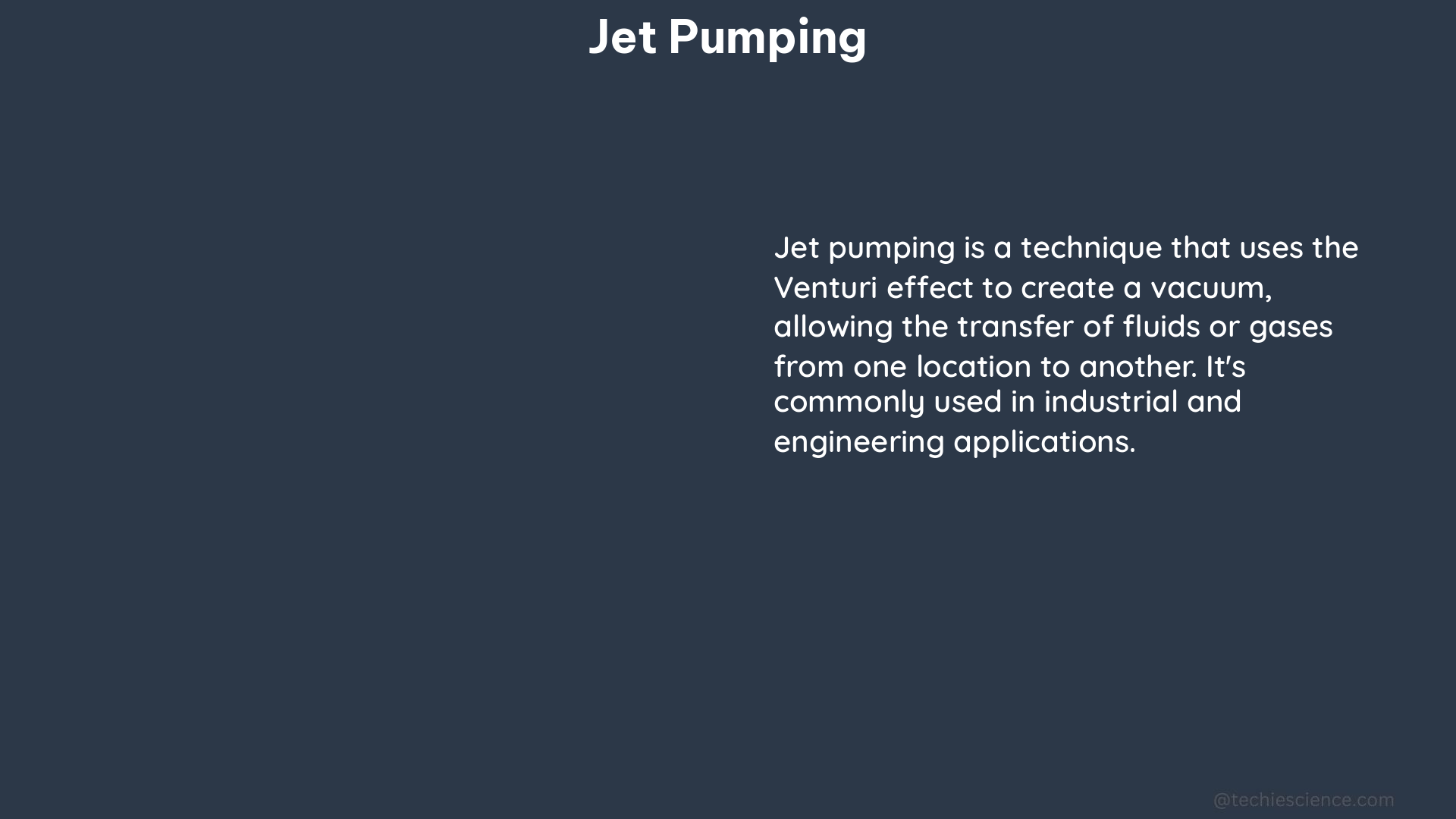Jet pumps are artificial lift methods that operate by passing a high-pressure fluid jet through a venturi system, creating a low-pressure zone that lifts fluid from the well. The efficiency of a jet pump is affected by various factors, including tap coefficients, fluid densities, geometric configurations, depth placement, injection rates, and pressures.
Understanding the Factors Affecting Jet Pump Efficiency
Tap Coefficients
The tap coefficient is a dimensionless parameter that represents the ratio of the actual flow rate through the jet pump to the theoretical flow rate. It is influenced by the design and geometry of the jet pump, as well as the fluid properties. Typical tap coefficients for jet pumps range from 0.6 to 0.9, with higher values indicating better efficiency.
Fluid Densities
The densities of the primary and secondary fluids in the jet pump system can significantly impact its efficiency. Higher density differences between the fluids can lead to increased entrainment and improved lift capacity, but may also result in higher energy losses due to the interaction between the fluid particles.
Geometric Configurations
The design and geometry of the jet pump, including the nozzle, throat, and diffuser, can significantly affect its performance. Optimizing the dimensions and shapes of these components can enhance the venturi effect, reduce flow separation, and minimize energy losses.
Depth Placement
The depth at which the jet pump is installed in the well can impact its efficiency. Deeper placement can increase the suction pressure and lift capacity, but may also result in higher friction losses and reduced flow rates.
Injection Rates and Pressures
The injection rate and pressure of the primary fluid (typically water or gas) can significantly influence the jet pump’s performance. Higher injection rates and pressures can increase the entrainment and lift capacity, but may also lead to higher energy consumption and wear on the system components.
Improving Jet Pump Efficiency through Swirling Primary Jet

A study conducted by researchers at the Norwegian University of Science and Technology (NTNU) compared the efficiency of a jet pump with and without swirl in the primary jet of a centrally driven jet pump. The results showed that the swirling primary jet increased the entrainment flow and efficiency of the jet pump.
The researchers found that the swirling motion of the primary jet created a stronger vortex in the mixing chamber, which enhanced the entrainment of the secondary fluid (typically oil or gas). This resulted in a higher discharge flow rate and improved overall efficiency of the jet pump.
The study also revealed that the swirling primary jet helped to reduce the energy losses due to the interaction between the fluid particles, as the vortex motion transformed the original gas-liquid axial motion into a more efficient vortex-dominated flow.
Enhancing Jet Pump Discharge Efficiency with Static Mixers
Another study on the efficiency of jet pumps found that the energy loss was large due to the interaction between fluid particles, and the efficiency was low. However, the researchers discovered that by combining a static mixer with an annular jet pump, the original gas-liquid axial motion was transformed into a stronger vortex motion, and the liquid droplets were changed into a liquid film that was easier to carry, significantly improving the discharge efficiency of the jet pump.
The static mixer helped to create a more uniform and stable flow pattern in the jet pump, reducing the energy losses and enhancing the entrainment of the secondary fluid. This resulted in a higher discharge flow rate and improved overall efficiency of the jet pump system.
Real-Time Data Analysis for Optimizing Jet Pump Performance
In terms of real-time data analysis for hydraulic jet pump systems, the benefits are numerous. By analyzing real-time data from sensors, meters, and gauges, operators can optimize the operating parameters to achieve maximum production rate and recovery. This includes adjusting the injection rates, pressures, and other variables to match the changing well conditions and maximize the efficiency of the jet pump.
Additionally, real-time data analysis can help detect and diagnose anomalies or faults in the jet pump system, allowing for proactive maintenance and preventing potential damage or downtime. This can lead to reduced energy consumption, water usage, chemical injection, and the frequency of interventions, repairs, and maintenance, ultimately lowering the operational costs of the jet pump system.
Conclusion
The efficiency of a jet pump is a complex interplay of various factors, including tap coefficients, fluid densities, geometric configurations, depth placement, injection rates, and pressures. By understanding and optimizing these factors, as well as incorporating innovative techniques like swirling primary jets and static mixers, the performance and efficiency of jet pump systems can be significantly improved.
Furthermore, the integration of real-time data analysis can provide valuable insights and enable operators to make informed decisions, leading to enhanced production optimization, system reliability, and reduced operational costs. As the oil and gas industry continues to evolve, the importance of optimizing jet pump efficiency will only grow, making this comprehensive guide a valuable resource for industry professionals.
References:
- Improving the efficiency of a jet pump using a swirling primary jet
- Efficiency of Jet Pumps
- How can real-time data analysis optimize hydraulic jet pump systems?
- Efficiency of Jet Pumps
- Improving the Efficiency of Annular Jet Pumps Using a Static Mixer
- Improving the Efficiency of Annular Jet Pumps Using a Static Mixer

The lambdageeks.com Core SME Team is a group of experienced subject matter experts from diverse scientific and technical fields including Physics, Chemistry, Technology,Electronics & Electrical Engineering, Automotive, Mechanical Engineering. Our team collaborates to create high-quality, well-researched articles on a wide range of science and technology topics for the lambdageeks.com website.
All Our Senior SME are having more than 7 Years of experience in the respective fields . They are either Working Industry Professionals or assocaited With different Universities. Refer Our Authors Page to get to know About our Core SMEs.